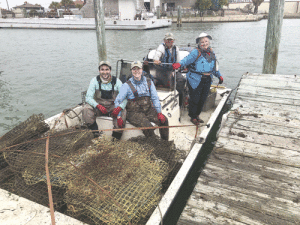
Allan Berger, Leslie Taylor, Ashley Berger, Alejandro Velasquez with crab traps to offload at TPWD dock.
Feb. 2021 Results for Texas MidCoast Bay Systems
Press Release by San Antonio Bay Partnership
Every February, Texas Parks and Wildlife Department closes the bays to commercial and recreational crabbing for a 10-day period. This temporary closure enables a coordinated effort by agencies and organizations to remove derelict crab traps which continue to entrap and kill crabs, fish, and turtles
.
This year, 1203 traps were removed from the three coastal bay systems on the
Texas mid-coast (Lavaca/Matagorda, San Antonio, and Aransas Bays). “It’s especially important to remove these old traps from the bays. Not only are they a source of ghost fishing, but they are also navigation hazards and unsightly litter,” said co-organizer Katie Swanson, Mission-Aransas Reserve Stewardship Coordinator at the University of Texas Marine Science Institute.
Removal of derelict crab traps was a massive effort this year involving 60 boat days and 148 volunteer days. The effort was led by San Antonio Bay Partnership, Mission-Aransas National Estuarine Research Reserve, the Lavaca Bay Foundation, and the Matagorda Bay Foundation who organized many groups, including U.S. Fish and Wildlife Service’s Aransas National Wildlife Refuge, Texas Parks and Wildlife Department Coastal Fisheries, local chapters of the Coastal Conservation Association, the Guadalupe Blanco River Trust , International Crane Foundation, Mid-Coast Texas Master Naturalists, Texas Sea Grant, Lavaca-Navidad River Authority, and individual citizen volunteers.
This is the second year that technology was used to collect data on each removed trap including: location, owner, and content. SABP Chairman Allan Berger stated, “The data reveals that many of the derelict traps are on the shoreline, likely the result of several storms this summer. However, a significant number appear to be in place and not picked up by commercial crabbers. It is anticipated that an analysis of the data can reveal root-causes and result in fewer lost traps in the future.”
“The effort was a great success thanks to the volunteers and organization that participated despite the disruptions of the winter storm. The weather reduced boats and volunteers. Further, TPWD recommended that the start of the effort be delayed three days to allow commercial crabber additional time to retrieve their traps since the winter storm had interrupted their work.”
Berger continues, “The loss of three days during the closure challenged the cleanup team to effectively search the bays in the remaining seven days. However, it was far better for the crabbers to retrieve their traps.”The tally is significantly lower than last year’s count of 1632. While a detailed analysis of the data remains to be completed, Berger anticipates that the cause is due both to fewer boats / volunteers and the crabbers having done a better job of retrieving their traps.
This year’s derelict crab clean-up effort was supported with funds from a NOAA Marine Debris Program Community-based Marine Debris Removal grant obtained by the Coastal Bend Bays and Estuaries Program, supplemented by local sponsors Guadalupe Blanco River Trust, Guadalupe Blanco River Authority, and the San Antonio River . In addition, in-kind support was provided by U.S Fish and Wildlife Service, Texas Parks and Wildlife Department, Texas Sea Grant, Bay Flats Lodge, Lavaca-Navidad River Authority, and the captains who provided their private boats.
Berger says that “While the cleanup is a lot of work, it is essential for keeping our bays clean and productive—and it’s fun.” If you want to be included in the early planning for next year, contact Allan Berger at SanAntonioBayPartnership@gmail.com
